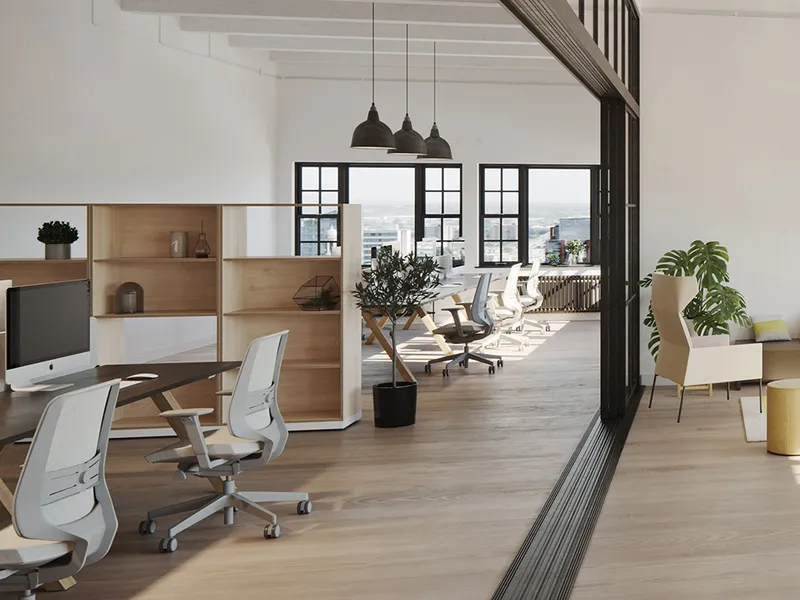Intro
In today’s environmentally conscious world, the need for sustainable office spaces and furniture has never been more crucial. The modern workplace is not only a hub for productivity and innovation but also a reflection of a company’s commitment to social and environmental responsibility. By incorporating sustainable practices, businesses can reduce their ecological footprint, create healthier working environments, and contribute positively to global conservation efforts. This article will explore the essentials of sustainable office spaces and furniture, delving into their benefits and offering valuable tips on how to create a greener and more efficient workspace. So, join us on this journey towards a more sustainable future and discover how your office can lead the way in environmental stewardship.
The Concept of Sustainable Office Spaces
The concept of sustainable office spaces goes beyond merely incorporating eco-friendly materials and furnishings. It encompasses a holistic approach to designing and managing a workspace that minimizes its environmental impact while maximizing employee well-being and productivity. The idea is to create a harmonious balance between economic, social, and ecological factors. By considering the entire lifecycle of the office space, from construction to decommissioning, businesses can optimize resource use, reduce waste, and create a healthier environment for employees and the planet alike.
A sustainable office space consists of several key components, each playing a vital role in reducing its ecological footprint. These components include energy efficiency, water conservation, waste reduction, a healthy indoor environment, and the integration of green spaces. For instance, sustainable offices may feature smart heating, ventilation, and air conditioning (HVAC) systems that minimize energy consumption. They may also incorporate water-saving fixtures, recycling and composting programs, and low volatile organic compound (VOC) paints and materials to reduce indoor air pollution. Additionally, integrating green spaces, such as indoor gardens or rooftop terraces, can improve air quality and foster a connection with nature, contributing to employee well-being.
Sustainable office furniture is another essential aspect of a green workspace. It is characterized by the use of eco-friendly materials, durability, and adaptability, as well as recyclability and up-cyclability. By selecting furniture made from responsibly sourced, renewable, or recycled materials, businesses can minimize deforestation and reduce the consumption of non-renewable resources. Furthermore, investing in durable, high-quality furniture reduces the frequency of replacement, thereby minimizing waste. When the time comes to replace or dispose of furniture, selecting items that can be easily recycled, upcycled, or repurposed further demonstrates a commitment to sustainability and resource conservation.
Sustainable Furniture Options
Sustainable furniture options are characterized by their eco-friendliness, durability, and adaptability. These pieces are crafted from materials that have minimal negative impact on the environment, often sourced from renewable or recycled resources. Additionally, sustainable furniture is designed to last, reducing the need for frequent replacements and thereby decreasing waste. Many eco-friendly furniture pieces are also modular or easily adaptable to changing workspace requirements, which further contributes to their sustainability. The ability to recycle or upcycle furniture at the end of its useful life ensures that valuable resources can be repurposed, preventing them from ending up in landfills.
There are several popular materials used in the production of sustainable office furniture, each with its unique environmental benefits. FSC-certified wood, for instance, guarantees that the timber has been sourced responsibly from well-managed forests, reducing deforestation and promoting biodiversity. Bamboo is another excellent choice, as it is a fast-growing, renewable resource that requires minimal pesticides and fertilizers. Recycled metal and plastic are also widely used in eco-friendly furniture, helping to decrease the demand for virgin materials and reduce energy consumption during production. Lastly, biodegradable materials, such as cork and plant-based fibers, are gaining popularity due to their ability to break down naturally, further minimizing environmental impact. By choosing sustainable furniture options, businesses can demonstrate their commitment to environmental stewardship while creating comfortable and functional workspaces for their employees.
Design Tips for a Sustainable Office Space
Designing a sustainable office space requires a thoughtful approach that takes into account various factors, from maximizing natural resources to choosing eco-friendly materials. One of the most impactful design tips for creating a sustainable office is to maximize the use of natural light. By incorporating large windows, skylights, and open floor plans, businesses can reduce their dependence on artificial lighting and decrease energy consumption. Natural light also offers numerous health benefits for employees, including improved mood and productivity, as well as reduced eye strain and fatigue. Additionally, when artificial lighting is necessary, opting for energy-efficient solutions, such as LED or CFL bulbs, can significantly reduce energy use and associated costs.
Another crucial aspect of designing a sustainable office space is selecting materials that contribute to a healthy indoor environment. This includes using low VOC paints, adhesives, and furnishings to reduce indoor air pollution and potential health risks. Incorporating plants and biophilic design elements can further enhance air quality while fostering a sense of well-being and connection to nature. Encouraging eco-friendly behaviors among employees, such as recycling, composting, and conserving energy, can also play a pivotal role in maintaining a sustainable workspace. Ultimately, by prioritizing sustainability in office design, businesses can create healthier, more efficient work environments that have a lasting positive impact on both the planet and their employees.
Benefits of Sustainable Office Spaces and Furniture
Sustainable office spaces and furniture offer a myriad of benefits that extend beyond environmental conservation. One of the most significant advantages is the positive impact on the health and well-being of employees. By prioritizing natural light, air quality, and biophilic design elements, sustainable workspaces can improve mood, reduce stress, and enhance overall productivity. Employees working in eco-friendly environments tend to experience fewer sick days and demonstrate higher job satisfaction, which in turn can lead to reduced staff turnover and improved company performance.
Financial benefits are another motivating factor for businesses to adopt sustainable office practices. While the initial investment in eco-friendly materials and furniture might be higher, the long-term savings can be substantial. Energy-efficient lighting and HVAC systems, for example, can significantly reduce utility costs over time. Additionally, durable and long-lasting furniture will minimize the need for frequent replacements, resulting in cost savings. Companies that invest in sustainable office spaces may also be eligible for tax incentives, rebates, and other financial benefits, depending on local government initiatives and regulations.
Lastly, the adoption of sustainable office spaces and furniture can significantly enhance a company’s image and reputation. Consumers and employees alike are increasingly concerned about environmental and social responsibility, and businesses that demonstrate a commitment to sustainability can set themselves apart from their competitors. By showcasing their dedication to green initiatives, companies can attract environmentally conscious customers, clients, and employees, fostering a positive and forward-thinking brand identity. In a world where sustainability is becoming a top priority, investing in eco-friendly office spaces and furniture is not only a smart business move but also a vital step towards a greener future.
Governments around the world are recognizing the importance of sustainable office spaces and have implemented various initiatives and incentives to encourage businesses to adopt eco-friendly practices. Tax incentives and rebates are common tools used by governments to stimulate investment in sustainable office infrastructure. These financial benefits can offset the initial costs of adopting energy-efficient systems, installing renewable energy sources, or implementing water-saving technologies. By providing financial support, governments can make it more appealing for businesses to invest in sustainable solutions, ultimately contributing to national environmental goals and global climate change mitigation efforts.
Green building certifications and standards play a crucial role in promoting sustainable office spaces. Programs such as LEED (Leadership in Energy and Environmental Design), BREEAM (Building Research Establishment Environmental Assessment Method), and Green Star assess buildings based on various sustainability criteria, including energy and water efficiency, materials used, waste management, and indoor environmental quality. These certifications not only provide a framework for businesses to follow when designing and constructing sustainable office spaces but also serve as a benchmark for measuring their success. Buildings that achieve high certification ratings can benefit from increased marketability and enhanced brand reputation, as they demonstrate a strong commitment to environmental stewardship.
Public-private partnerships for sustainability are another avenue through which governments can encourage the development of sustainable office spaces. By collaborating with businesses, non-profit organizations, and other stakeholders, governments can pool resources, share knowledge, and develop innovative solutions to environmental challenges. These partnerships may involve joint research projects, pilot programs, or the implementation of best practices for sustainable office design and construction. By fostering cooperation and shared responsibility, public-private partnerships can significantly contribute to the widespread adoption of sustainable office spaces and pave the way for a more environmentally responsible future.
Conclusion
In conclusion, sustainable office spaces and furniture are essential components of an environmentally responsible future. As businesses increasingly recognize the importance of adopting sustainable practices, the benefits of eco-friendly workspaces become ever more apparent. From improved employee health and well-being to long-term cost savings and enhanced brand reputation, investing in sustainable office design is a win-win for both companies and the planet. By exploring sustainable furniture options, prioritizing energy efficiency, and incorporating green design elements, businesses can contribute to global conservation efforts while creating healthier, more productive work environments.
As governments continue to support sustainable initiatives through incentives, certifications, and partnerships, the momentum for greener office spaces will only grow. It is our collective responsibility to embrace sustainability and strive for a future where both businesses and the environment can thrive. By taking action now and committing to sustainable office spaces and furniture, we can help shape a brighter, more sustainable world for generations to come.

